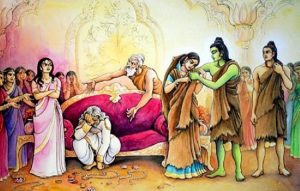The post In Defense of Lord Ram appeared first on Dharma Today.
]]>No ancient story, not even Homer’s Iliad or Odyssey, has remained as popular through the course of time. The story of Ram appears as old as civilization and has a fresh appeal for every generation. – David Frawley (The Oracle of Rama)
Did Lord Ram love Sita as much as Sita loved Him? In the Ramayana, spanning over 24,000 verses, the descriptions of Ram’s lamentation after losing His wife are heart-wrenching. It’s obvious He was dedicated to Her as she was to Him.
Rishi Valmiki has devoted four chapters to describe Ram’s intense separation from his wife (Aranya Khanda-chapters 60-63). In the next section (Kishkindha Khanda- chapter 27) when Ram is at the Parsvana mountain, He is again despondent, and his younger brother Lakshman gives him hope.
Later in the Uttara Khanda Ram is forlorn at the prospect of losing His beloved Sita; He cries to Lakshman that He’d know no happiness without Her. Although it was a common tradition then for kings to have many wives, His father had more than three hundred, Ram chose to rule for the next ten thousand years without one. He suffered in separation.
Ironically, Ramayana reveals Ram as an emotional person who deeply loved his wife, a stark contrast to what is made of Him by certain Indologists.
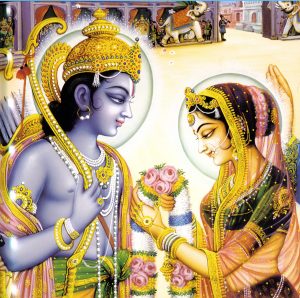
Therefore the basic premise with Ram as a chauvinist, and Ramayana, a product of a culture that breeds on macho bigotry is wrong. Ram’s attitude was exemplary. He was tender hearted, and selfless. He gave up his own pleasures, to follow the path of righteousness.
Yet, a common challenge posed by the educated, yet confused Hindu is:
“Ram was selfish; he was more interested in his own reputation than to protect his chaste wife, Sita.”
The proof: He abandoned mother Sita because he heard a washer man, who disowned his wife for staying with another man one night, accuse: “I am not like the coward, infatuated Ram, who would accept a wife even after she stayed with another man.”
Thus, the argument: ‘Ramayana teaches values that are out dated and inhuman’.
However, if Ram was a coward why would He even fight a bloody war? And If he was selfish would He send Her away; would He not keep Her with Himself? To answer this we need to understand the principle of dharma as Duty.
The Dharma Conflict
Dharma is derived from the Sanskrit ‘Dhr’ which means ‘to sustain’, ‘carry’ or ‘hold’’. Each one of us is responsible to live in a way that helps human society sustain life, in harmony with cosmic laws. The universe is sustained by subtle laws, and when we confirm to righteous behaviour, say as parents we care for our child, we make our contribution to ensure this balance. That is called dharma.
The challenge however would be when two duties conflict and you could choose only one. Unlike the animals that act on instinct, humans are bestowed with the gift of choice.
For instance, your boss insists on working late hours, but your child repeatedly falls sick, and you need to give more attention to her. What’s the right thing to do?
Dharma is also relative; what is deceit in one situation could become truth in another. A man chased by assailants, knocks on your door. Would you give him shelter? If you do, and moments later, the muggers ask if you have seen a man they were chasing come over, would you speak the truth? Or would you rather mislead them so that an innocent life is saved?
Dharma is personal. Although we are guided by many – the wisdom books, family, and friends – it’s ultimately our conscience, the inner moral compass that directs our daily decisions.

Ram had a tough decision to make. His cabinet of ten trusted ministers confirmed that many citizens scorned him for his blind love for Sita. As a king, He was condoning apparent adultery by accepting Her. They denounced not Sita, but Ram. He knew a king’s currency to serve is the mandate of his citizens.
As a husband, what Lord Ram did could be unacceptable, but considering his other role as a king, He was in a dharma conflict. To declare His decision as faulty is very amateurish. Most of us naturally think and act within our limited views of life. We are not kings, and may have no idea of what it means to keep thousands of other people happy and in order. We may even find it strange when one choses to suffer to serve others. And that’s what Ram did. When Vibhishana offered Lord Ram the kingdom of Lanka, the Lord denied, saying, “Mother and motherland are greater than heaven”. To serve his country the best way he could, he sacrificed his love.
“But is Sita not a citizen? Should Ram not protect her?”
Did Ram Abandon Sita?
No!
While Ram was banished by Kaikeyi, He did not do the same with His wife. He cared for Her by sending Her to Rishi Valmiki’s ashram where saintly women attended to Her needs, and gave Her spiritual shelter. As she wept feeling pangs of separation from Her Lord, Ram too cried remembering His beloved Sita.
While Ram’s exile was a result of an evil ploy, Sita being sent to the ashram was Ram’s sincere attempt to balance His different dharmas.
Mother Sita’s Response
If Ram’s exile was a life of uncertainty, Sita’s stay in Valmiki’s ashram was a life of devotion; She accepted the decision with grace and maturity, knowing the intricacies of kingly dharma.
Additionally Sita was not a timid, emotionally abused woman who was forced to toe her husband’s line of thought. She was independently thoughtful, and assertive.
Indeed earlier, it was Her decision to accompany Lord Ram to the forest. When Lord Ram persuaded Her to stay back at Ayodhya, arguing that forest life is fraught with dangers, She admonished Ram. She wondered aloud if Her father had married Her off to a woman who was in the guise of a man! Ram, seeing Her determination, took Her along.
Now at the ashram, she accepted Her situation as the inevitable twists and turns of life, on which we have little control.
Sita Knew Her Dharma
After killing Ravana, Ram cried as he announced to Sita that he had nothing to do with Her. She was furious, and decided to enter fire to prove her chastity. The incident was orchestrated by the Lord to present to the world Sita’s purity. This is confirmed in Koorma Purana: Sita was under the care of God of Fire, and through the fire test, she was returned to Ram.
Sita very well knew her duties, and she chose to follow her dharma. If Ram’s decision to send her to the Ashram was a wrong one, she would have refused to honour it, just as years ago she refused to stay back at the palace when he told her to.
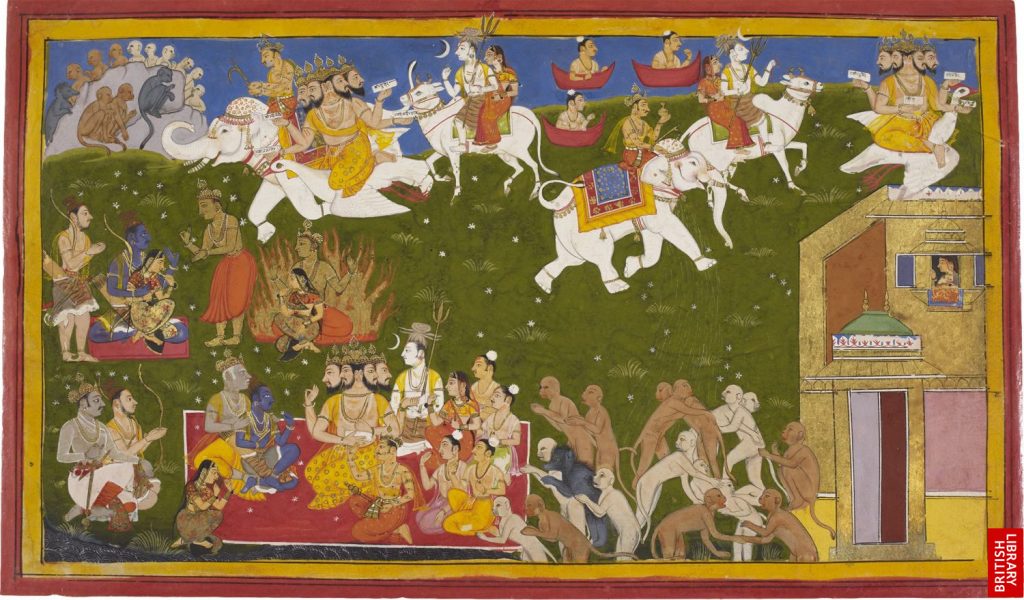
In another instance, when Hanuman told Sita to hop on her back so that he could take Her safely to Ram, She again revealed Her clear thinking and decisive action. There was little time to lose, and Hanuman was offering Her a chance to escape from Ravana’s Lanka. Yet she refused, insisting that it was the duty of Her husband to come and fight Ravana, and take Her honourably from Lanka.
Three Levels to See the Pastime
Ram sending Sita away could be seen at three levels.
- The challenge of balance
We have various duties, and it’s not easy to perform all of them. If we could perform even fifty per cent of our expected dharma, we’d consider ourselves successful. Ram, on this occasion, reveals our delicate predicament in this world. One could imagine that if Lord Ram, despite his best intentions, is not free of censure, how much more difficult it is for us to perform our dharma?
If one phoo-phoo’s the dharma conflict, it only means he or she hasn’t lived long enough; life always throws up dilemmas, and you have to simply live long enough to experience them.
- A leadership lesson
Lord Ram’s incarnation had the specific purpose of setting the example of an ideal leader.
In different incarnations, the Lord fulfils a specific purpose. As Parashuram, He annihilated the warrior class twenty one times. As Buddha, He taught non-violence. One can’t accuse Parashuram of not doing what Buddha did. Similarly as Krishna, the Lord cared for all his sixteen thousand wives; he even lied and cheated to protect His devotees. He was the incarnation of a lover, who broke all rules to reciprocate with his beloved. But when He came as a sannyasi, Shri Chaitanya Mahaprabhu, he had no dealings with women. Likewise as Lord Ram, his purpose was to teach us how a true leader is willing to give up what he loves the most, for a larger good.
- Love in seperation
The Lord has his own agenda and internal reason for his incarnation.
Lord Ram relished the mellow of vipralambha bhava or love for his devotees in separation.
When two lovers meet, there is happiness. But when they are separated, the intensity of emotions churned in the heart is richer. The pain of not being with the beloved strengthens the lovers hankering.
This principle applies even in our relationship with God. The desperation in separation is a greater devotional ecstasy than physically being in the Lord’s association.
Lord Ram’s Humanness
Lord Ram and His devotees experienced this love many times. When Ram was banished to the forest, His father Dasharath and the citizens of Ayodhya felt deep pain of separation. Bharat and Ram too felt this reciprocal love. An old and simple woman named Shabari who waited for years to see Ram, exemplifies serving the Lord in separation and hope.
While Ramayana is filled with pastimes exemplifying this mood, Sita-Ram’s separation is the pinnacle of this emotion. The time they spent in separation churns the reader’s heart with love and tenderness. Interestingly, in Lord Krishna’s pastimes, devotees are seen crying in separation but we hardly find Krishna crying in separation from his devotees. However in Lord Ram’s pastimes, the Lord’s lamentation and his transcendental emotional outbursts are there for all to see. This helps one appreciate Lord Ram’s humanness; and feel the love He feels for us.
The Paradox of Ramayana
The most beautiful paradox of the Ramayana story is that there is pain and suffering, yet it’s deeply nourishing and irresistible for the reader. Usually when we read a tragedy, there is meaningless pain. However the suffering in Ramayana is like the hot chutney – sauce of Indian cuisine. The chillies and spice burns the tongue, yet it tantalizes one’s senses; one wishes to have more of it. Bhaktivedant Swami gave the example of hot sugar cane juice. The temperature makes one uncomfortable to drink it, yet the sweetness entices one to drink more of it.
Ramayana begins with Rishi Valmiki, the author, seeing the painful separation of a female Crauncha bird (Sarus Crane) that witnesses her partner being shot by a hunter. She wails piteously, and Valmiki feeling compassion for the suffering bird, pronounces a curse on the hunter. Even as he succumbs to anger, Valmiki is surprised that his outburst came out in perfect poetic meter. As he wonders about this incident, the leader of the universe, Lord Brahma appears before him and explains how his cursing is a propitious sign; it’s an indication that he should write the Ramayana, extolling the glorious love of Lord Ram and his devotees for each other. The cursing of the hunter becomes the first verse of this immortal classic, and sets the mood of transcendental sorrow and love in separation, for the remaining part of the book.
The Ramayana ends with Sita going back to her abode, under the earth, and thus intensifying Lord Ram’s separation from her.
The post In Defense of Lord Ram appeared first on Dharma Today.
]]>The post Self Determination appeared first on Dharma Today.
]]>But that determination by which one holds fast to selfish results in religion, economic development and egoistic gratification is of the nature of passion.
– Bhagavad Gita (18.34)
Although human history reveals men and women of great character, these pages also contain names of people who teach us what not to do in life. Men with strong determination, yet misdirected ambitions, have wreaked havoc on civilizations.
One such case is the invader Babur, the founder of Mughal Empire in India.
At the age of eleven, Babur became the king of Fergana valley (in present day Uzbekistan) with his interests in poetry, art, music and gardening. Despite being a descendant of the dreadful Timur from his father’s side and the terrible Genghis Khan from his mother’s lineage, he chose to follow their footsteps, even if he wasn’t cut out for it. Both these conquerors had legendary, cult status in the medieval Muslim world for their brutality and wholesale massacres of civilian populations. It was then natural for Babur, a young impressionable boy at that time to nurture similar ambitions.
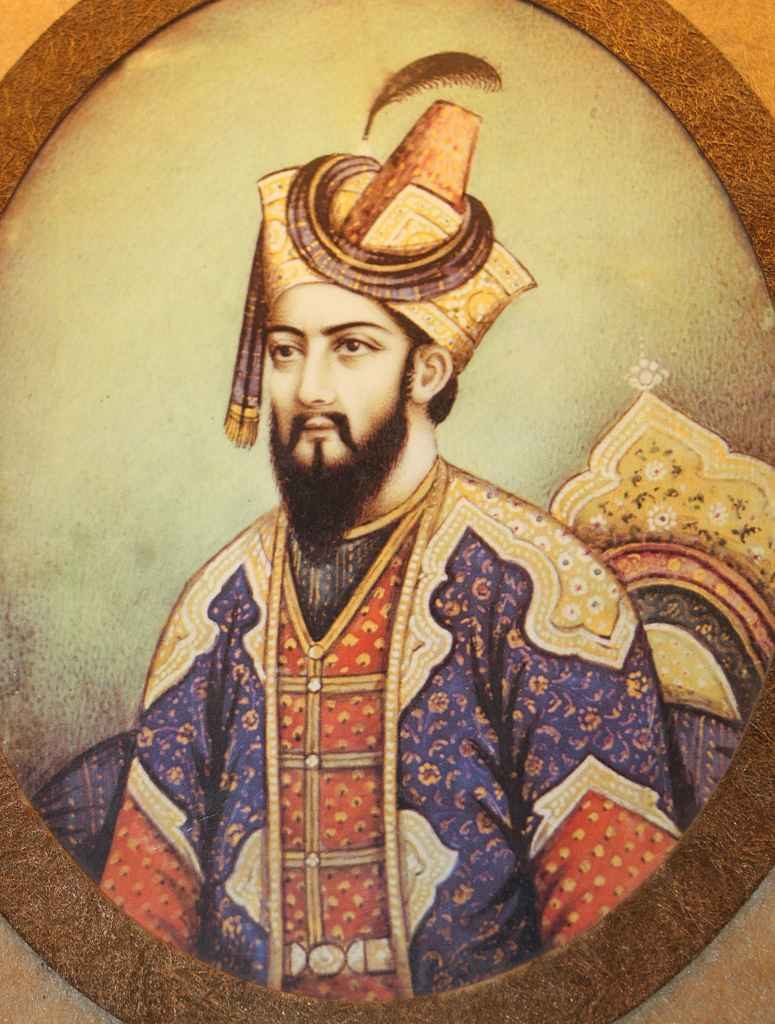 Desires swelled in his heart; he first sought to conquer Samarkand, a city in modern-day Uzbekistan, in honor of Timur who was born there. A young ambitious teenager, Babur began his march to seek power.
Desires swelled in his heart; he first sought to conquer Samarkand, a city in modern-day Uzbekistan, in honor of Timur who was born there. A young ambitious teenager, Babur began his march to seek power.
At the age of fifteen after a great struggle, Babur managed to gain control of Samarkand, but lost it in a few months. Meanwhile in his absence his brother usurped his native Fergana valley. Babur was thus left with no kingdom. He repeatedly tried to get Samarkand, and was obsessed, but faced constant failures. Finally, frustrated, he came back to retain Fergana, but even here he lost terribly.
He wandered in the mountains of Central Asia after escaping with a small band of followers and took shelter of tribes in these hilly regions. He endured poverty and humiliation and lost all hopes of regaining his country.
Babur writes in his memoirs that he had ascetic-spiritual tendencies, which was unnatural amongst his war mongering clan. And this was a good time for him to pursue his inner calling. Yet he chose to seek pederasty, a high fashion of the central Asian aristocrats of that time. He developed strong infatuation for a young sixteen year old boy and possessed several wives. In a life enveloped by bisexual relationships and ambitions to seek power, his asceticism and humanness was buried for good.
Slowly he focused on building a strong army and sought luck elsewhere. He captured Afghanistan but continued to abhor the vices and luxuries of Herat and Kabul; he found liquor and intoxicants disgusting.
Now Babur set his eyes on India. At that time the northern India was ruled by Ibrahim Lodi, and those who detested him, invited Babur to conquer Delhi. Here again, he faced failures. In 1524 when his army was routed by Lodi, Babur responded by burning the entire city of Lahore for two days, killing scores of innocent people and causing terrible destruction.
Two years later during the first battle of Panipat, Babur, equipped with artillery and cannons that were unknown to the Indian army then, defeated Lodi. Later he also defeated Rana Sangha of Mewar, again with his artillery that had no match, and Babur now became the undisputed Lord of Northern India.
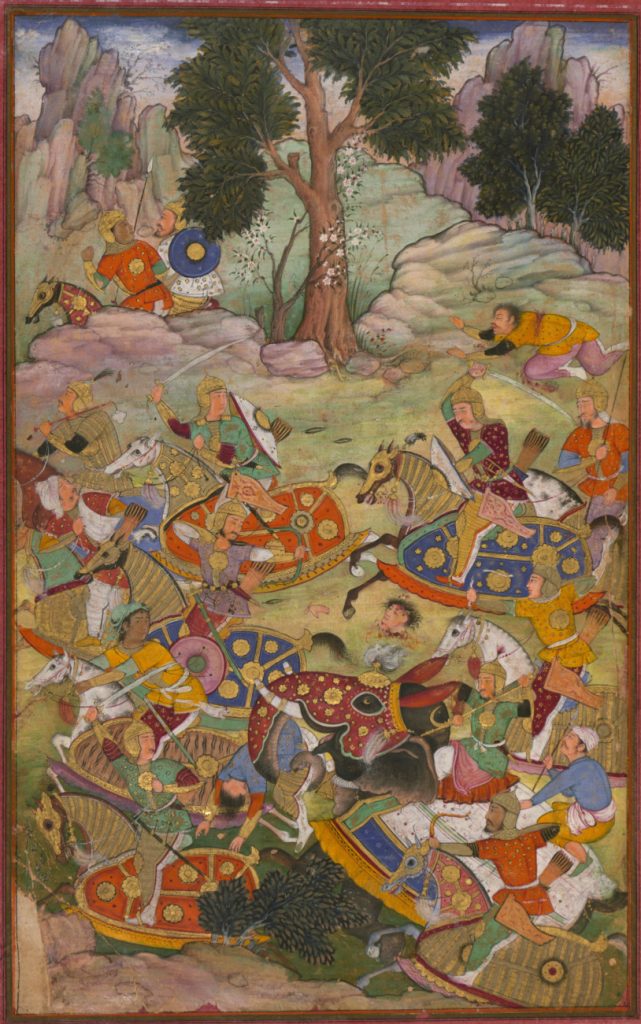
One would imagine he now had enough reasons to be happy. But ironically, now he began to drink, host wine parties and take opium and other narcotics. And he wasn’t happy. Historian Abraham Eraly reveals that even amidst this success in India he regretted that he couldn’t conquer Samarkand. His heart ached for what he failed to get elsewhere.
And is it difficult to know why he wasn’t happy? The Greek philosopher Epictetus answered it, “Happiness and personal fulfillment are the natural consequences of doing the right thing.”
While Babur prided himself as a holy warrior of Islam, during this period India saw the emergence of Guru Nank, the founder of Sikh religion who taught religious harmony. In stark contrast to Babur’s Jihad, India saw Vaishnavism branch of Hinduism take roots. And the Vaishnava saints taught the message of peace and love of God.
Babur developed excellent war strategies but wasn’t happy. He was at last doing things right, and that gave him victories, but was he doing the right things?
Babur had a chance to be a saint; he simply had to follow his calling. He could have been a messenger of peace and love, but he lost it. Babur could have, like the other saints, pursued his inner quest, yet he chose to be an agent of hate and violence. And what an irony, while he conquered India, he missed the Indian spirituality, and terribly lost his internal war. His ambition and determination led him to great external success, but at what cost? The most influential African American social reformer of the eighteenth century, Fredrick Douglas made a beautiful appeal to our conscience, “I prefer to be true to myself, even at the hazard of incurring the ridicule of others, rather than to be false, and to incur my own abhorrence”
We are constantly faced with distractions and temptations, and it’s not easy to follow our inner calling. Especially when the soft inner voice implores us to be an agent of positivity, but our raging mind and senses, impelled by the ego, direct us to do the wrong things. Paradoxical as it may sound, conscience is that still, small voice that is sometimes too loud for our comfort. Yet if we show courage and determination to follow the right but difficult path, we may be pleasantly surprised as we reach a beautiful destination. The right choices always give right results.
The truth is that you always know the right thing to do. The hard part is doing it. While Babur died long before he was buried, we could choose to live and love.
The post Self Determination appeared first on Dharma Today.
]]>The post Why is the Ramayana Attractive? appeared first on Dharma Today.
]]>Besides Rama’s relatives, there were others like Hanuman who performed heroic acts with deep humility and love for the Lord. Jatayu, a vulture, bravely laid down his life trying to protect Sita while she was being abducted by Ravana, the king of demons. The love for the Lord was the guiding force for each of these devotees, who joyfully and gratefully accepted inconveniences to serve Him. In contrast, Ravana and his associates display the psychology of modern humans – wanting everything for themselves, and using everyone and everything for their own interests. Ravana professed to love Sita but when she refused to yield to his advances, he threatened to kill and eat her for breakfast! The Ramayana portrays good and evil in unambiguous terms and sharp contrasts.
Joy of Sacrifice
What is it about Lord Rama’s pastimes that even millennia after they happened, they remain ever fresh and inspire people from all walks of life? Ramayana has always been the foundation of Indian ethos, and has attracted all because it exemplifies the highest degree of character, integrity and sacrifice:
- Rama displays unparalleled detachment from power and position.
- Sita reveals the highest standard of chastity and dedication.
- Lakshman could have continued to remain in the palace for he was not ordained to go to the forest, but chose to accompany, selflessly serve and protect Rama and Sita.
- Urmila, at the insistence of her husband Lakshman, remained in Ayodhya to care for the three mothers who would feel intense separation from the Rama and Sita. Her service was to give hope and encouragement to those who missed the Lord. Thus her being in the royal palace was as much a sacrifice as Sita giving up her royal comforts.
- Bharat could have easily accepted the throne and kingdom bestowed upon him. He insisted that the throne belonged to Lord Rama and chose the life of an austere caretaker till Rama returned from the forest after fulfilling his father’s order.
Sacrifice is universal
Coming to more recent times, a young Indian soldier laid down his life during the Kargil war. His fiancé was just 23 then. While he became a martyr for the Nation’s cause, she chose to remain unmarried and thus sacrificed her life for the cause of love. Both sacrifices touch the heart because personal pleasure is forsaken for a higher cause. Generally, people seek gratification, so those who chose to relinquish their desires inspire others to love, serve and be selfless. Compassion and sacrifice touch the heart and brings tears to the eyes.
Amazingly, today’s lovers emulate Ravana and inflict harm when their beloved refuse to reciprocate. Recently a boy grievously and permanently injured the beautiful face of a girl, by throwing acid because she didn’t love him the way he ‘loved’ her. Similarly, They even glorify Ravana’s forbearance in not forcing himself on Sita, while she was in his custody. Little do they know the facts! Once Ravana raped a heavenly damsel and her husband had cursed that if Ravana ever forced himself on any woman again, he would die. The Ramayana reveals that it was the fear of the curse coming true that prevented Ravana from enjoying Sita.
Today people eulogize evil and portray Ravana as a hero – someone superior to Rama. This reveals the dangerous mindset of humans. Little wonder that in contrast to the young soldier who laid down his life, we have politicians who sell the country for vested interests, and lovers who cheat on their partners without shame or remorse. Therefore, it’s time now to reestablish Rama Rajya – the kingdom of Rama consciousness, where everyone wants to serve, love, and live for others.
The post Why is the Ramayana Attractive? appeared first on Dharma Today.
]]>